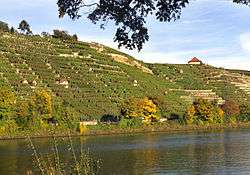Württemberg (wine region)
Württemberg is a region (Anbaugebiet) for quality wine in Germany,[1] and is located in the historical region of Württemberg in southwestern Germany, which today forms part of the federal state of Baden-Württemberg. Under German wine legislation, Württemberg and Baden are separate wine regions.

With 11,511 hectares (28,440 acres) under vine in 2008, Württemberg is Germany's fourth largest wine region.[2] Winemaking cooperatives are very common in Württemberg, number around 70, and are responsible for almost 75% of the region's production.[3] Unlike most other German regions, Württemberg has a long history of producing red wines, although from somewhat different varieties than other German wine regions.
Geography

Most of the Württemberg wine region is situated around the river Neckar and several of its tributaries, Rems, Enz, Kocher and Jagst. The geography of the wine region is dominated by these river valleys and include several south-facing slopes. The main part of Württemberg is situated between the cities of Stuttgart and Heilbronn.[4] There are also vineyards on Lake Constance that belong to Württemberg.
Grape varieties
71% of the vines grown in Württemberg are of red grape varieties. The most common variety in Württemberg, and the region's signature grape, is the red wine grape Trollinger, which was planted on 21.2% of the vineyard surface in 2008.[2] Trollinger gives red wines which are light in both colour and style (and occasionally made in a slightly sweet style) and Württemberg accounts for over 98% of plantings of Trollinger in Germany. Other common red varieties are Schwarzriesling (Pinot Meunier, which despite its German name is not related to "genuine" Riesling) at 15.1%, Lemberger (same as Austria's Blaufränkisch) at 13.9% and Spätburgunder (Pinot noir) at 11.1%. The most common white variety is Riesling (18.1%).
The most cultivated grape varieties, by area in 2008, were:[5]
|
|
References
- Wein.de (German Agricultural Society): Wuerttemberg, read on January 1, 2008
- German Wine Institute: German wine statistics 2009/2010 Archived July 26, 2011, at the Wayback Machine
- Wein-Plus Glossar: Württemberg, read on January 23, 2013
- J. Robinson (ed), "The Oxford Companion to Wine", Third Edition, p 776, Oxford University Press 2006, ISBN 0-19-860990-6
- Landwirtschaftliche Bodennutzung - Rebflächen - Fachserie 3 Reihe 3.1.5 - 2008 [Agricultural land use - Areas under vine]. Wiesbaden, Germany: Statistisches Bundesamt. 2008.